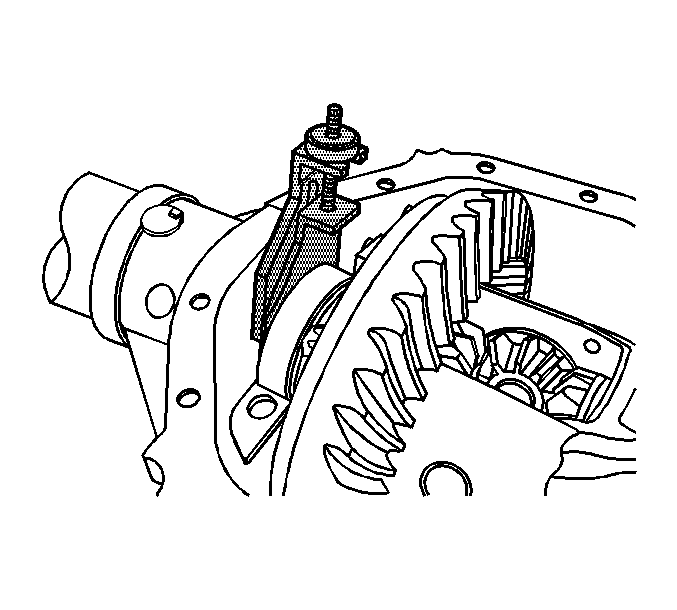- Disconnect the propeller shaft from the rear axle and support as necessary. Refer to
Rear Propeller Shaft Replacement
.
Caution: To prevent personal injury and/or component damage, support the differential
case when removing the case from the axle housing. If the case is not supported,
the differential case could fall and cause personal injury or damage to the
differential case.
- Remove the differential assembly from the axle housing, if necessary.
- Measure the rotating torque of the drive pinion bearing using an inch-pound torque wrench.
Specification
The rotating torque of the drive pinion should be 1.7-3.4 N·m (15-30 lb in) for new bearings or 1.1-2.3 N·m (10-20 lb in) for used bearings.
- If the rotating torque of the drive pinion is less than 1.7 N·m (15 lb in) for new bearings or 1.1 N·m (10 lb in) for used bearings, tighten the pinion in small increments until the specified
rotating torque is obtained.
- If the rotating torque of the drive pinion is greater than 3.4 N·m (30 lb in) for new bearings or 2.3 N·m (20 lb in) for used bearings, remove the drive pinion and replace the collapsible spacer
and re-install the drive pinion. Refer to
Drive Pinion Bearings Replacement
.
- Install the differential assembly into the axle housing, if necessary.
- Support the differential assembly in order to prevent the differential assembly from falling out of the axle housing.
Important: Do not force the ring gear into contact with the drive pinion.
- Slide the differential case assembly towards the right side axle housing until the ring gear contacts the drive pinion.
This is the ZERO backlash point.
If the ZERO backlash cannot be obtained, turn the differential bearing adjuster nut into the axle housing using the
J 24429
until the ring gear fully contacts the drive pinion to obtain the ZERO backlash.
- While holding the ring gear against the pinion, turn the differential bearing adjuster nut out from the axle housing using the
J 24429
until it contacts the differential side bearing.
- Turn the adjuster nut out from the axle housing an additional 2 slots using the
J 24429
in order to obtain the initial backlash adjustment.

- Install the
J 22779
into the left side axle housing between the differential bearing bore and the differential bearing cup.
Important: Over-tightening may spread the axle housing and result in incorrect shim selection.
- Tighten the knob of the
J 22779
until there is moderate drag when the
J 22779
is moved.
- Remove the
J 22779
.
- Measure the
J 22779
in 3 locations.
- Calculate the average of the 3 measurements.
The resulting value is the shim thickness required in order to set the initial backlash of the differential assembly.
- Select a service shim of approximately the same thickness to install into the axle housing.
Verify the thickness of the service shim using a micrometer.
- Install the service shim into the axle housing between the differential bearing bore and the differential bearing cup.
- Install the left and the right side differential bearing caps.
- Install the left and the right side differential bearing cap bolts.
Tighten the differential bearing cap bolts finger-tight. Do not torque the bolts at this time.
- Firmly tighten the differential bearing adjuster nut using the
J 24429
in order to force the differential case assembly into solid contact with the service shim.
- Rotate the pinion several times in order to seat the bearings.
- Loosen the differential bearing adjuster nut using the
J 24429
until the nut is free from the differential side bearing.
- Tighten the differential bearing adjuster nut using the
J 24429
until the differential bearing adjuster nut contacts the bearing.
- Once the right differential bearing adjuster contacts the differential bearing, tighten the differential bearing adjuster nut using the
J 24429
the following additional amounts:
Tighten
| • | For new bearings, tighten the differential bearing adjuster nut an additional 3 slots. |
| • | For used bearings, tighten the differential bearing adjuster nut an additional 2 slots. |
- Install the right differential bearing adjuster nut lock.
- Install the right differential bearing adjuster nut lock bolt.
Do not torque the bolt at this time.
Notice: Refer to Fastener Notice in the Preface section.
- Tighten the bearing cap bolts.
Tighten
Tighten the bearing cap bolts to 85 N·m (63 lb ft).
- Measure the drive pinion and differential case side bearing preload using an inch-pound torque wrench.
Rotate the pinion several times to ensure the bearings have seated.
Specification
The rotating torque of the drive pinion and differential case bearings should be 3.9-6.2 N·m (30-55 lb in) for new bearings or 2.8-5.1 N·m (25-45 lb in)
for used bearings.
Record the measurement.
- Calculate the differential side bearing preload by subtracting the drive pinion preload, measured in Step 2, from the drive pinion and differential case bearing preload, measured in Step 35.
Multiply the value obtained by the axle ratio.
Specification
The differential case side bearing preload should be 1.7-4.0 N·m (15-35 lb in).
- If the differential case side bearing preload is too low, tighten the differential bearing adjuster nut in 1 slot increments until the specified rotating torque is obtained.
- If the differential case side bearing preload is too high, loosen the differential bearing adjuster nut in 1 slot increments until the specified rotating torque is obtained.
- Once the differential side bearing preload is correct, measure the drive pinion to differential assembly backlash and adjust, if necessary. Refer to
Backlash Adjustment
.

